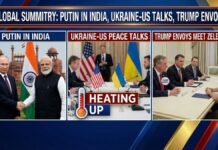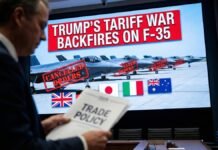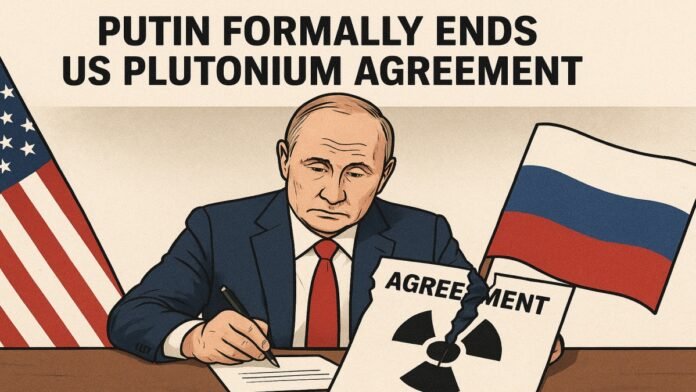
Key Points
- Russian President Vladimir Putin signed a law on October 27, 2025, formally terminating the Plutonium Management and Disposition Agreement with the United States
- The agreement, signed in September 2000 and ratified in 2011, required both countries to dispose of 34 metric tons of weapons-grade plutonium each enough material to produce approximately 17,000 nuclear warheads
- Russia had already suspended the accord in October 2016, citing US “hostile actions,” sanctions, NATO expansion, and Washington’s unilateral changes to plutonium disposal methods
- The formal denunciation also terminates all associated protocols governing funding mechanisms, civil liability, and reactor irradiation arrangements
- Russia recently announced successful testing of the Burevestnik nuclear-powered cruise missile, which Putin claims has unlimited range and no global equivalent
- The withdrawal ends one of the last remaining nuclear arms control mechanisms between the two superpowers, raising serious concerns about global nuclear security
- The move comes amid cooling relations between Putin and US President Trump, with mounting frustrations over stalled Russia-Ukraine peace negotiations
Moscow: Russian President Vladimir Putin officially signed legislation on Monday, October 27, 2025, formally terminating the already defunct Plutonium Management and Disposition Agreement with the United States, marking the end of one of the most significant post-Cold War nuclear arms control initiatives. The lower house of the Russian Parliament, the State Duma, approved the withdrawal bill on October 8, 2025, followed by consent from the upper chamber, the Federation Council, the following week.
The legislation came into effect immediately following Putin’s signature on Monday, bringing to a formal close an agreement that had been effectively dormant since 2016. In addition to withdrawing from the main agreement, Russia has also denounced all associated protocols that previously governed funding mechanisms, civil liability for potential damages, and technical arrangements for disposing of plutonium through irradiation in nuclear reactors.
The bilateral agreement, originally signed in August 2000 shortly after Putin’s first inauguration and amended in 2010, represented a landmark achievement in nuclear disarmament efforts following the Cold War era. It committed both Moscow and Washington to reduce their vast Cold War-era stockpiles by disposing of 34 metric tons of weapons-grade plutonium each, material that was declared surplus to military needs and could be converted to civilian nuclear power applications.
Historical Context and Agreement Details
The Plutonium Management and Disposition Agreement was considered one of the key steps in nuclear disarmament in the immediate post-Cold War period. US officials estimated that the agreement would eliminate weapons-grade material sufficient to produce the equivalent of approximately 17,000 nuclear weapons, representing a substantial reduction in the nuclear arsenals of both superpowers.
Russia ratified the agreement in 2011, with plans to launch a comprehensive program to reprocess plutonium as a component of mixed oxide (MOX) fuel for nuclear power plants originally scheduled for 2018. The agreement went into full effect in 2011, establishing detailed protocols and timelines for both nations to fulfill their plutonium disposal obligations.
However, significant challenges emerged in implementation on both sides. The United States government had initially intended to convert the plutonium into safer MOX fuel through the construction of the Mixed Oxide Fuel Fabrication Facility at the Savannah River Site in South Carolina. However, this project was terminated in 2019 due to escalating costs and technical difficulties.
Instead, the National Nuclear Security Administration pivoted to pursuing a “dilute and dispose” strategy wherein weapons-grade plutonium would be downblended with inert materials and permanently stored at the Waste Isolation Pilot Plant in New Mexico. This unilateral change in disposal methodology by Washington became a major point of contention with Moscow.
2016 Suspension and Growing Tensions
Russia’s path to complete withdrawal began in October 2016 when Moscow suspended the agreement via presidential decree and federal law. At that time, Russia accused Washington of violating its obligations under the treaty by changing the technical requirements and procedures for plutonium disposal without first obtaining consent from Russia, as required under the agreement’s provisions.
Beyond the technical disputes, Russian officials cited a comprehensive list of geopolitical grievances as justification for the 2016 suspension. These included the imposition of US and European sanctions against Russia following the 2014 annexation of Crimea, the adoption of the US Ukraine Freedom Support Act, NATO’s eastward expansion into former Soviet territories, and the deployment of US military forces and equipment in Eastern European countries bordering Russia.
The explanatory note accompanying the 2025 withdrawal legislation reiterated these concerns, stating that “a threat to strategic stability from the US” prompted the denunciation. Among Russia’s political demands are the complete removal of all sanctions imposed after the 2014 occupation of Crimea and financial compensation for economic losses caused by those restrictions, demands that Washington has consistently rejected.
Sergei Ryabkov, Russia’s Deputy Foreign Minister, stated when presenting the withdrawal bill to the State Duma that maintaining Moscow’s obligations under the plutonium agreement with Washington is “unacceptable under current circumstances”. He emphasized that continuing participation in the agreement while facing comprehensive Western sanctions and political isolation would contradict Russia’s national security interests.
Burevestnik Missile: Nuclear-Powered Deterrent
The formal withdrawal from the plutonium agreement coincides with Russia’s announcement of successful testing of the Burevestnik nuclear-powered cruise missile, a weapon system that President Putin has characterized as having no equivalent anywhere in the world. In his address to the Federal Assembly, Russia’s bicameral parliament, Putin stated that Moscow had developed a small-sized nuclear power unit that could be used in a cruise missile to extend its range “practically indefinitely”.
According to Putin, the Burevestnik represents a revolutionary advancement in missile technology, featuring a low-flying profile with an unpredictable flight trajectory that would make it extremely difficult for conventional missile defense systems to intercept. Russian officials claim that during recent tests, the missile remained airborne for approximately 15 hours and covered a distance of about 14,000 kilometers (8,700 miles), demonstrating unprecedented operational capabilities.
Putin announced that Russia had completed final testing of the weapon system and would now work toward full deployment with the Russian armed forces. The Burevestnik, also known by its NATO reporting name “Skyfall,” has been under development for several years and has faced numerous technical challenges, including a catastrophic test failure in 2019 that resulted in multiple fatalities and radioactive contamination at a testing facility in northern Russia.
The timing of the Burevestnik announcement alongside the plutonium agreement withdrawal sends a clear strategic signal that Russia intends to maintain and even expand its nuclear capabilities despite international arms control efforts. Defense experts interpret this as Moscow’s response to what it perceives as Western strategic pressure and military encirclement.
Impact on Russia-US Relations
The withdrawal comes at a particularly sensitive moment in Russia-US relations, with mounting tensions between President Putin and US President Donald Trump over the stalled Russia-Ukraine peace process. Trump has expressed increasing frustration with Putin for refusing to accept the proposed peace deal terms for ending the conflict in Ukraine, which has now entered its fourth year.
President Trump scrapped plans for a highly anticipated peace summit with Putin last week, characterizing it as a potential “waste of time,” and ruled out rescheduling unless the Russian leader sends clear signals that he would agree to substantive concessions in a negotiated settlement. White House Press Secretary Karoline Leavitt stated that “the president has always maintained that he would implement sanctions on Russia when he felt it was appropriate and necessary,” confirming that the Trump administration recently imposed new sanctions on Russian oil companies as pressure tactics to force Moscow toward a peace agreement.
“The president has also long expressed his frustration with Vladimir Putin and both sides of this war,” Leavitt said during a White House press briefing, indicating that Washington holds both Russia and Ukraine accountable for the prolonged conflict. The new sanctions target major Russian energy exporters, aiming to reduce Moscow’s revenue streams that fund its military operations in Ukraine.
The plutonium agreement withdrawal effectively eliminates one of the last remaining mechanisms for bilateral cooperation between the two nuclear superpowers on arms control and non-proliferation issues. With the collapse of the Intermediate-Range Nuclear Forces (INF) Treaty in 2019, the suspension of the New START Treaty’s verification provisions, and now the termination of the plutonium disposal agreement, the entire architecture of US-Russia nuclear arms control built over decades is rapidly disintegrating.
Global Nuclear Security Concerns
International security experts have expressed deep concern that the withdrawal from the plutonium agreement raises serious questions about the future of global nuclear security and strategic stability. The termination of the accord means that 68 metric tons of weapons-grade plutonium, 34 tons held by each country, will now remain in military stockpiles indefinitely rather than being converted to civilian uses or permanently disposed of as originally intended.
Western leaders have repeatedly accused Russia of nuclear saber-rattling since it launched its full-scale invasion of Ukraine in February 2022. Days after beginning the offensive, Putin placed Russia’s nuclear forces on heightened alert status, sending shockwaves through global capitals and raising fears of potential nuclear escalation. In September 2024, Putin signed a decree formally lowering the threshold for Russia’s potential use of nuclear weapons, expanding the scenarios under which Moscow might authorize a nuclear strike.
Russian Security Council officials have defended the country’s nuclear posture, stating that “the collective West fails to understand the nature of Russian interethnic relations, the spiritual, moral strength, and the unity of the multinational Russian people, which allows us to resist destructive geopolitical technologies confidently”. This rhetoric emphasizes Russia’s determination to maintain strategic autonomy and resist what it characterizes as Western attempts to undermine its national interests.
Analysts warn that the combination of formal withdrawal from the plutonium agreement, development of new nuclear delivery systems like the Burevestnik, and increasingly aggressive nuclear rhetoric could destabilize the global atomic balance and potentially trigger a new arms race. The move sends a message to Western countries that Russia will no longer tolerate strategic pressure policies and is prepared to pursue military-technical solutions to perceived security threats.
The denunciation of the plutonium agreement effectively ends one of the last vestiges of post-Cold War nuclear cooperation between Washington and Moscow, raising fundamental questions about whether meaningful arms control arrangements remain possible in the current geopolitical environment. As diplomatic channels narrow and military tensions escalate, the international community faces mounting challenges in preventing nuclear proliferation and maintaining strategic stability in an increasingly multipolar world.
